Hosts Inventory
This option displays the list of Hosts monitored by WOCU-Monitoring. In addition to listing the Assets, WOCU-Monitoring also provides information on their Status and allows the user to perform common operation Actions.

Important
Remember that it is possible to filter the Hosts displayed in the inventory by searching for: name, IP address and status information (content of the Status Information column) of the Host.
Host Inventory Fields
The display of the inventory fields (columns) is configurable via the Columns option. This functionality allows the user to dynamically select which columns to show in the table view and which ones should remain hidden. More information at: Customizing table display: Columns.
Attention
There is a maximum restriction of 9 simultaneously visible columns, in order to preserve the readability and performance of the interface.

Además, la aplicación incorpora soporte para el redimensionamiento dinámico de columnas de la tabla, permitiendo al usuario ajustar manualmente el ancho de cada columna según las necesidades de visualización. Más información aquí.

Possible fields are:
Display/hide Services
The field contains only one element indicating the possibility to show and hide the Services associated with the Host. By clicking on the icon with the plus sign (Display/hide services) you can access these services:

To retract the Host services click on the icon (now a minus sign) and the listed Services will disappear from view:

Note
In order to make it easier for the user to read data in the inventory, the rows corresponding to a Service shall always have a white background, regardless of its Status while the rows of the Hosts shall vary their background colour depending on their status (see Status field below).
Type
This field houses an icon that identifies the type of Asset in the Inventory.
- Hosts
The (physical) Hosts are identified with the house icon.

- Business Process Hosts (BP Hosts)
Business Process Hosts (BP Hosts), i.e. logical hosts, are identified with the icon of the house framed in a circle.

- Services
Services are identified by the intersecting arrows icon. You can view the Services of a Host by displaying them through the view options.

- Business Process Services (BP Services).
The Business Process Services (BP Services) are identified with the icon of the arrows crossing each other framed in a circle. The Business Process Services of a Host can be viewed by displaying them through the view options identifying those Services defined as such.

Note
Placing the cursor over the icons will display a text reminding the type of element (Host, Service, BP Hosts / BP Service).
An icon represented by the capital letter P shall be assigned to identify Passive Services. This indicates that these services come from passive monitoring, via SNMP Traps.

This condition implies the following limitations:
Disabling Enable active checks for service and Reschedule next check for this service executable on the service.

Disabling the Check Now button of the widget Status, blocking the forced refresh for obtaining the of the service in real time.
Name
The Host Name differentiates the Host from the rest and is determined by the value of the Display name attribute (this Display name attribute will be described in more detail in the next sections).
By placing the cursor over this field, the IP address of the Host can be queried. Clicking on the name of the Host, Business Process or Service will take you to its corresponding Detailed view of Hosts and Business Processes and Detail view of Services and Business Processes.
Attention
Only when the Host has Monitoring Packs associated, the system shall set after the Name, identifying icons (of manufacturers, technologies, operating systems…) referring to these applied packs.
The system will display a maximum of three icons ordered by a predefined weight scale, giving priority to the most representative and relevant (and least generic) icons/packs of the Host’s monitoring profile.
Placing the cursor over a particular icon will bring up a text alluding to the technology represented.
More information can be found at: 1. Display technology identification icons on Assets, Problems and Events pages..
Status
Through this field WOCU-Monitoring informs about the Statements of Assets in WOCU of the Device.

In the case of services associated with devices, also status information is provided.
Last Check
This field reports the date of the last verification of the Host Status. In parallel and independently, the same individualised Last Check information is recorded and displayed for each of the Services associated to a Host.
Duration
The field indicates how long the Host has been active in WOCU, i.e. the time without a crash or total failure. In parallel and independently, the same individualised Duration information is recorded and displayed for each of the Services associated with a Host.
Status Info
The field collects a message that expands the information about the current status of the Host. The nature of the messages will vary depending on the type of monitored Host and its configuration. In parallel and independently, the same individualised Status Information is recorded and displayed for each of the Services associated with a Host.
Attention
If the text is too large for the space available on your screen, WOCU-Monitoring will truncate the text. To read the full text, simply place the cursor over the message.
Services States
Provides a summary of the Status of the Services associated with the Host. The text of the percentage varies in colour depending on the greater or lesser availability of the Services (green with all Services in OK Status, red with all Services in Critical Status and yellow if at least one Service has a Status other than OK). Numerical data indicates to the user the percentage of Services in correct operation (OK Status) and in brackets the specific number of services in OK Status out of the total number of Services.
Acts
This column contains visual information for the user in the form of icons. The leftmost icons inform about the application of Actions on the corresponding Host in that row.

These icons have a direct correspondence with the icons used in the Actions column which will be described later.
Note
You can easily find out what these icons mean by placing your cursor over them.

Hovering the cursor over any of the comment icons displays a summary view in a pop-up description of the comments added to this item:

The view consists of three fields (from left to right): identifier number, author and comment text.
Note
For more information and options for managing comments, use the Show Comments action described below.
The other option offered by this column is the display of graphs of the desired Asset. To do so, place the cursor on the icon of the graph within the row of the corresponding Asset and the graph for the selected Host will appear. Depending on the type of Host and configuration, the resulting graph may vary.
The graphics display option is also available for the Services associated with the Hosts. To do so, simply scroll down the list of Host Services and place the cursor on the row corresponding to the desired Host Service:

Attention
Clicking on the graph will redirect the user to the section Metrics.
Templates
This field contains a series of labels informing the user of the the configuration models used and assigned to the host.
To display this field, use the function Columns.
Attention
If the text is too large for the space available on your screen, WOCU-Monitoring will truncate the text. To read the full text, simply place the cursor over the message.
Packs
This field contains a series of tags that inform the user of the configuration of the monitoring profile assigned to the host.
To display this field, use the function Columns.
Attention
If the text is too large for the space available on your screen, WOCU-Monitoring will truncate the text. To read the full text, simply place the cursor over the message.
Poller tag
This field contains the label used to explicitly assign a Poller (node in charge of performing discovery and execution tasks of checks) to a Device within the system. To display this field make use of the Columns function.
Address
This field contains the IP address of the Device. To display this field make use of the Columns function.
Actions
Through this field, the user can make annotations, queries and even modify some of WOCU’s operating parameters. To access the commands, simply click on the actions icon, a drop-down menu will appear showing the options.
This screenshot shows such a drop-down menu for a Host:

Like the Hosts, it is possible to perform operations on the Services thanks to the Actions menu. In this case the menu will vary in the descriptive texts of the actions but not in the actions, which will be practically the same.

Because of their significance, the Actions are detailed one by one in the following section.
Actions on inventoried hosts
Show Host Events
The system shall display the Show hosts events action in the first position (Show hosts events).
In fact, the action is applied on the Device or on one ofyour Services, the result will be a view of Events of the Device itself, collected during the last twenty-four hours.

This view is explained in detail in Events, as it provides the user with information similar to that provided in the above referenced section.
Apply accepted or recognised status
The Apply acknowledged to Host option will set the acknowledgement label to the Host in question. Once this action is applied, the Host will show the thumbs-up icon in the column of icons and graphics discussed above. This will make it easier to know in advance which Problems have already been handled and which have not.
To apply the acknowledgement (ACK) the action must be selected from the menu. After the selection a small window will appear with a form where the user can register in more detail the operation to be completed, as well as modify the treatment of the Problems in future occurrences.
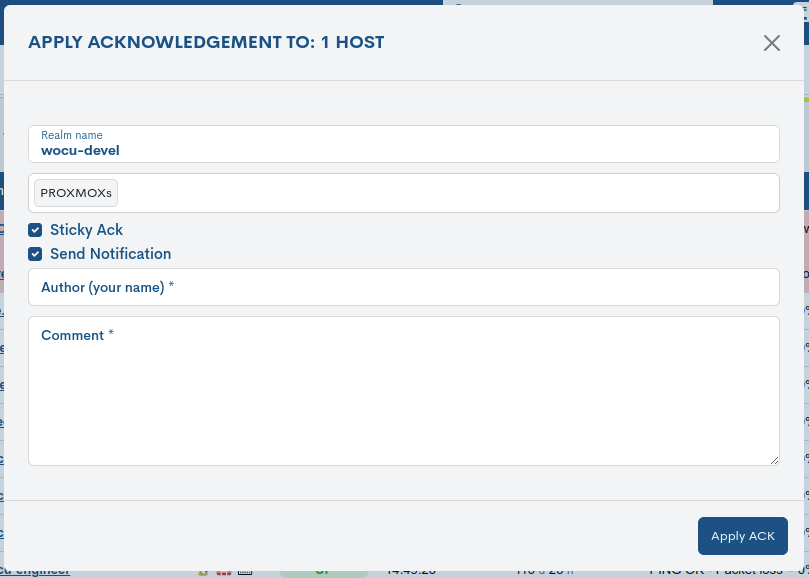
The Apply Accepted or Recognised Status window has the following fields:
Realm name: Field automatically filled in by the system indicating the Realm to which the Host or Service corresponds.
Host name: Field automatically filled in by the system indicating the name of the Host in WOCU.
Service name: Field automatically filled in by the system indicating the name of the Service in WOCU-Monitoring (this field will only appear when performing the recognition action in Services).
Set Acknowledge (Sticky Ack): This selectable option configures WOCU-Monitoring to re-acknowledge Alarms on future occurrences in the Asset until the option is disabled. The option will prevent constant acknowledgement of an alarm in the system in case of repetitive known problems.
Send Notification: This selectable option configures WOCU-Monitoring to send the notification pre-set in your configuration (email, SMS, etc.). The option will prevent the constant sending of messages for an Alarm on the selected Asset in case of repetitive known problems.
Author your name: This is the space where the user must enter their name or identifier so that it is recorded in the system who has acknowledged the Alarm in the Asset.
Comment: This is the space in which the user acknowledging the Alarm in the Asset must enter a text explaining, generally, the reasons for the acknowledgement action. Normally this space will be used to write down the number of the incident generated, if working with a ticketing tool (incident log) or any other information considered appropriate to keep the other users of the monitoring tool informed.
Once you have completed (at least) the required fields, those marked with asterisks, by clicking on Apply ACK the acknowledgement will be applied to the Host or Service.
Note
Acknowledgement is a common task in the daily operation of alarm handling in monitoring tools and WOCU-Monitoring integrates this function through this Action.
To undo the acknowledgement, select the Remove Acknowledged option. A window will ask the user to confirm the Action (Are you sure you want to remove the acknowledgement?). Clicking the OK button will apply the change.

Whether you reconnoitre or remove it from a Host or Service, the system will display the following notification:

(“The requested action has been successfully processed. The updated information will be available soon.”)
Disable Active Checks
The Disable active checks for host and/or all services / Disable active checks for service option suspends the active monitoring tasks that WOCU-Monitoring is performing on the Host or Service to which it is applied.
Active monitoring in WOCU-Monitoring consists of a set of checks performed to assess the connectivity to the Hosts and the operational status of the Services associated with the Hosts.
Once this action has been applied, the Host or Service will show the icon of the prohibition signal in the column of icons and graphics mentioned above. This will make it easier to know in advance which Hosts or Services have the active monitoring option disabled.
To apply the disabling of active monitoring on a Host or Service, the action must be selected from the menu.
In the case of a Host, a window will appear with a configuration form like the one below:

The Disable Active Checks window for the Host and/or its services has the following fields:
Apply to the host: The checkbox allows to apply the disablement only to the selected Host.
Apply to all services: The checkbox allows the disabling to be applied to all Services of the selected Host.
Realm name: Field automatically filled in by the system indicating the Realm to which the Host or Service corresponds.
Host name: Field automatically filled in by the system indicating the name of the Host in WOCU.
Clicking on the Disable Active Checks button will interrupt active monitoring on the Host and/or Host Services.
To re-enable active monitoring on the Hosts, or to make changes to the monitoring configuration, select the Enable active checks for host and/or all services option. A window will appear, with the same fields as above.

By selecting the options, Apply to Host or Apply to all Services, it is possible to enable/disable WOCU-Monitoring checks on the selected Host and/or its Services. Once the desired configuration is achieved, save the changes by clicking the Enable Active Checks button.
Attention
This action may be useful in the analysis, evaluation or debugging of overloaded monitored Hosts, network problems or congestion etc.
Whether you disable or re-enable active monitoring of a Host or Service the system will display the following notification:

(“The requested action has been successfully processed. The updated information will be available soon.”)
Add/Show comments
The Add comment option, Add comment to host for Hosts and Add comment to service for Services, allows reflecting information as a note associated to a Host or Service.
Once this action has been applied the Host or Service will display the speech bubble icon in the icons and graphics column discussed above. This will make it easier to know in advance which Hosts or Services have notes or comments.
Attention
This option can be used to record an important fact or circumstance related to a host or service. It is a very useful tool for transmitting and sharing information through work teams that share the use of the tool. It is also useful as a reminder.
Once the option has been selected, a small window will appear with a form where the user can register the note he/she wishes to add to the Asset.

The Add Comment window has the following fields:
Realm name: Field automatically filled in by the system indicating the Realm to which the Host or Service corresponds.
Host Name: Field automatically filled in by the system indicating the name of the Host in WOCU-Monitoring.
Service name: Field automatically filled in by the system indicating the name of the Service in WOCU-Monitoring (this field will only appear when performing the recognition action in Services).
Author your name: This is the space where the user must enter his or her name or identifier so that the system records who the author of the comment is.
Comment: This is the space in which the user must enter the text of their note or comment. Normally this space will be used to write down any relevant information about the Asset that the user considers important to share with the rest of the users of the tool.
Once you have completed (at least) the required fields, those marked with asterisks, by clicking on Add Comment the comment will be registered in the Host or Service.
If there is already a comment associated to a Host or Service, WOCU-Monitoring will show in the list of Actions the option Show comments. Through this option it is possible to visualise the comments associated to this element, as well as to add new comments or delete previously registered comments.
Once you have selected the Show comments option, a small window will appear allowing you to view and manage comments on an item as shown below:

The Comments window displays in successive rows the different comments entered in relation to an item monitored in WOCU (Host or Service). The comments are numbered sequentially: Comment 1, Comment 2 … (Comment 1, Comment 2 …) with the information recorded for each comment appearing in three fields:
Id: Numerical identifier of the comment, preceded by the hash symbol (#) to the left of the other elements.
Entry type: Displays and defines the comment through three elements that adjectivise the comment. These three elements that make up the Entry Type are juxtaposed, i.e. the Entry Type always consists of three terms plus an identifying icon that precedes them. The three terms correspond to the Comment Type, the Comment Source and the Asset Type. These three terms are defined in more detail below:
Type of Comment
Depending on the Comment Type, the first of the terms can take on four values:
Type
Description
User
Identifies comments manually entered by the user through the Add Comment action in this Asset.
Downtime
It identifies the comments automatically entered by WOCU-Monitoring when the user performs a Schedule downtime action on this Host.
State alternation (Flap)
Identifies comments automatically entered by WOCU-Monitoring when there is a rapid alternation of state changes (flapping) in this Asset (the comment is automatically deleted when this phenomenon ceases).
Acknowledgement
It identifies the comments automatically entered by WOCU-Monitoring when the user performs an Apply Acknowledged action on this Host.
Origin of the Commentary
Depending on the Origin of Comment the second of the terms can take two values:
Type
Description
Internal
It identifies comments entered by WOCU-Monitoring autonomously as part of its internal functioning.
External
Identifies comments entered as such by the user, and as such, external to WOCU’s mechanics.
Type of Asset
Depending on the Type of Asset to which the comment refers, the third of the terms can take two values:
Type
Description
Host
It identifies comments associated with a WOCU-Monitoring Asset that is a Host.
Service
Identifies those comments associated with a WOCU-Monitoring Asset that is a Service associated with a Host.
Attention
To illustrate this explanation with an example, the Entry Type “Downtime Internal Host” indicates that the Comment Type is a downtime, which was generated automatically by WOCU-Monitoring when the user executed the action “Schedule Downtime” on a Host asset. The Entry Type “User External Host” indicates that the Comment Type comes from the user’s execution of the “Add Comment” action, therefore being externally sourced from the WOCU engine, on a Host asset.
Entry time: Shows the date and time when the comment was created.
Author: Displays the information entered in the Author field when the comment was created. This will normally identify the user who registered the comment.
Message: Displays the information entered in the Comment field when the comment was created. Normally here you will note some relevant information associated with the Asset, and that you want to share with all users of the tool.
By clicking on the red bin icon button to the right of each comment it is possible to remove individual comments. To remove all comments associated with this Asset click on the red Remove All button.
When creating or deleting a comment/s the following message will appear:

(“The requested action has been successfully processed. The updated information will be available soon.”)
If you want to add new comments click on the white button Add Comment. After selecting the action the window with the Add Comment form shown above will appear. The process for entering a comment is the same as described above.
Comment management overview
Having selected several Hosts for the simultaneous display of their comments (via the selector Massive actions on inventoried hosts), the system will present the following management view:
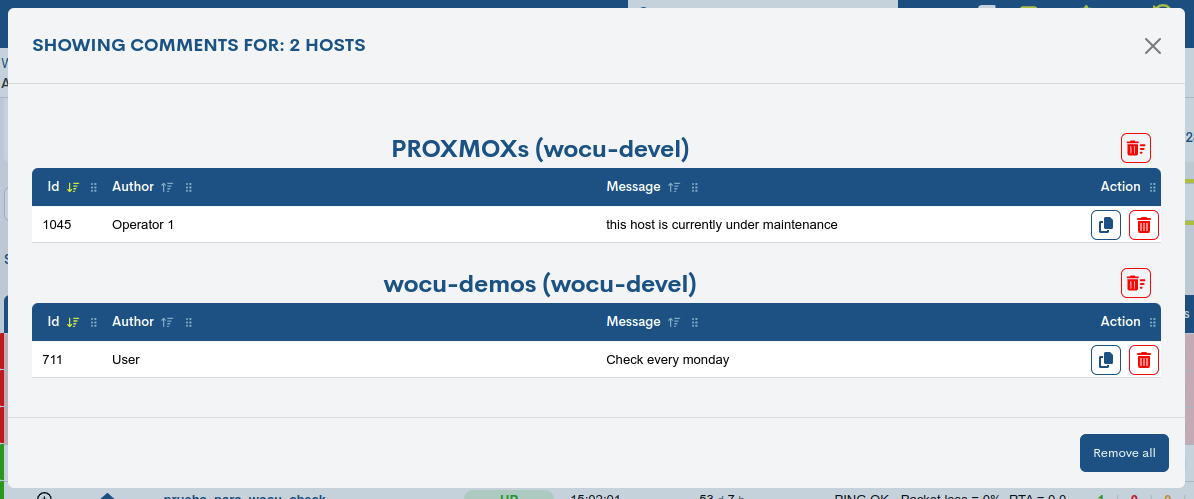
In this space there are different modalities for the definitive deletion of comments:
1. Deletion of an individual comment:

The comment with Id 1045 associated with the Host PROXMOX has been deleted.
2. Deletion of all comments associated with a particular Host:

The comments with Ids 1045 and 7104 associated with the Host PROXMOX have been deleted.
3. Mass deletion of comments associated with the Hosts previously selected in the inventory:
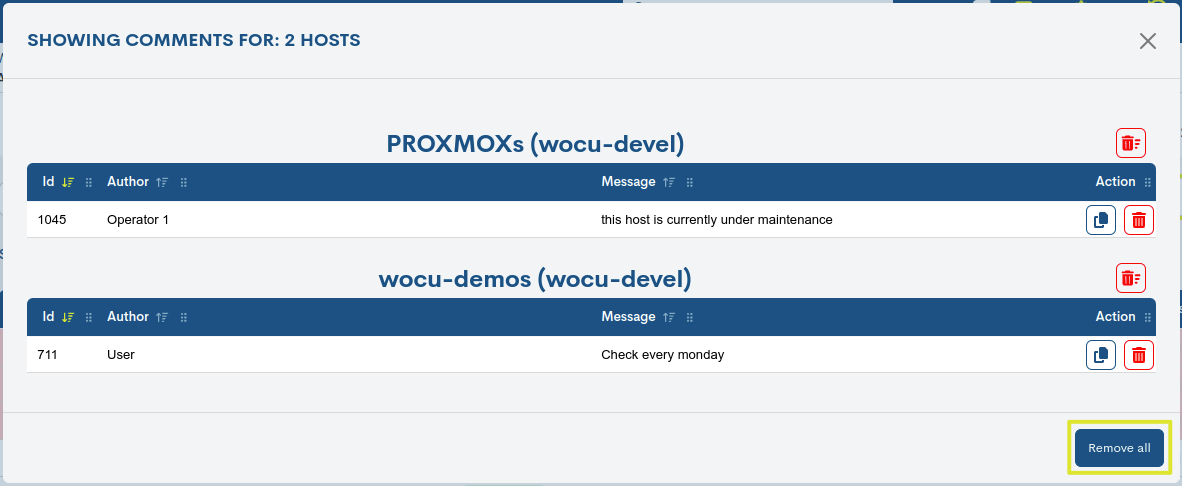
All comments associated with the Hosts PROXMOXs and wocu-demos have been deleted.
Program drop time
The Schedule downtime option, Schedule downtime for hosts and/or all services for Hosts and Schedule downtime to service for Services, allows you to inhibit for a certain period of time the warnings and alarms of an Asset that is going to suffer a downtime or other known and/or planned event that will affect the status of the Asset.
Once this action is applied, the Host or Service will display the calendar icon in the previously mentioned column of icons and graphs. This way, it will be easier to know in advance which Hosts or Services have a temporary suppression of Alerts scheduled in WOCU-Monitoring.
Note
This tool is very useful in case of interventions or scheduled maintenance in which the generation of Alarms in a Host or Services is foreseen. In this way, the user present in front of the WOCU Alarms console when the intervention or event takes place will be spared the processing and study of these Alarms.
Once the Schedule downtime option has been selected, a small window will appear with a form where the user can set the Alarm disabling period. The following is the window for programming the downtime of a Host:
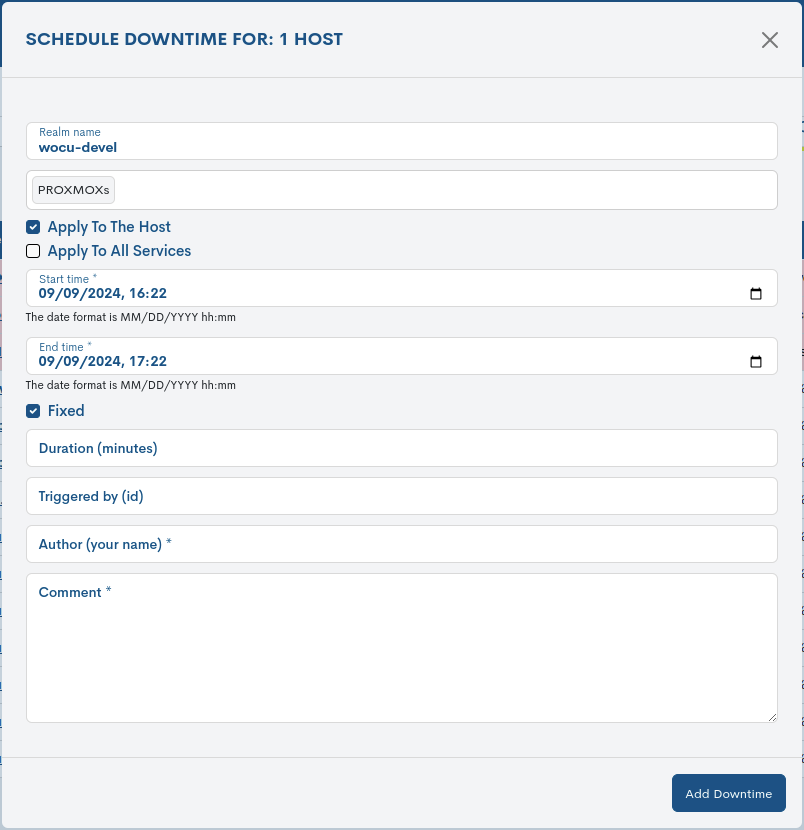
The Schedule Drop Time window has the following fields:
Apply to the host: The checkbox allows the programming to be applied only to the selected Host.
Apply to all services: The checkbox allows the scheduling to be applied only to all Services of the selected Host.
Realm name: Field automatically filled in by the system indicating the Realm to which the Host corresponds.
Host name: Field automatically filled in by the system indicating the name of the Host in WOCU.
Start date (Start time): Field in which the programming start date and time must be entered. From this moment on, the Host Alarms and/or its services will not be displayed (according to the previously established configuration).
End time: Field in which the date and time of the end of the programming must be entered. From this moment on, the Host Alarms and/or its services will be displayed again (according to the previously established configuration).
Attention
The date format is as follows: yyyyy-mm-dd hh:mm (yyyy-mm-dd-hh:mm) with
yyyyyybeing the four digits of the year,mmthe two digits of the month,ddthe two digits of the day,hhthe two digits of the hour andmmthe two digits of the minutes. Between each of the date elements (year, month and day) enter a hyphen (-) as a separator character, then a space and then the time, separating hours and minutes with a colon (:). If any of the elements has only one digit, fill the other digit with a zero to the left.Example for 3 February 2021 at half past one in the morning:
2021-02-03 01:30.Fixed: This checkbox (checked by default) disables the following field Duration Minutes and preserves the time interval set in the parameters Start time and End time, i.e. the exact duration of the scheduled drop.
Duration Minutes: If the previous option is unchecked, you can configure the time expressed in minutes that the planned downtime for the Host (and/or Services) will last from the Start time. By configuring the downtime in this way, it shall not be necessary to indicate the End time. From the set start time, WOCU-Monitoring shall activate the fall time as soon as the Host or Service changes State.
Triggered by id: By entering the id of another programmed downtime (Id of another downtime), the present downtime is programmed according to a previously existing downtime. When that one is activated, this one shall also be activated.
Author your name: This is the space in which the user must enter his or her name or identifier so that the system records who is the author of the programming.
Comment: This is the space in which the user must enter a comment relating to the established schedule. Normally this space will be used to note the circumstances that could cause the Alarms and for which the programming is established.
Once you have completed (at least) the required fields, those marked with asterisks, by pressing Add Downtime the scheduling will be activated in WOCU, disabling the Alarms in the set period.
In the case of programming on one of the services of a Host, the window will vary in some fields:
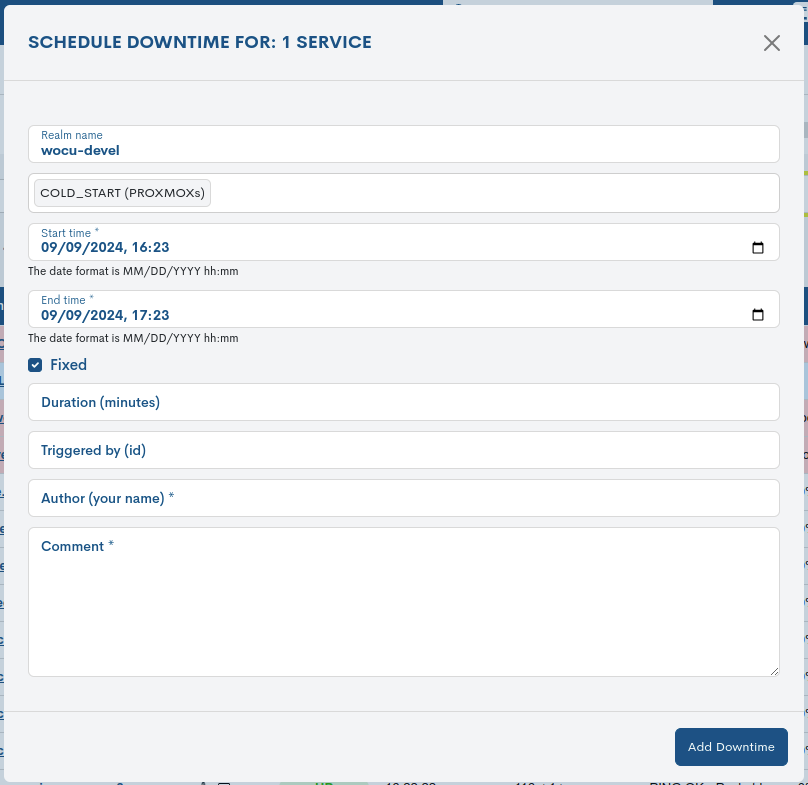
The options in the checkboxes will not appear, as the programming cannot be applied from here to the Host, nor to the other Services.
Service name: Field automatically filled in by the system indicating the name of the Service in WOCU-Monitoring (this field will only appear when performing the recognition action in Services).
For the rest of the fields follow the same instructions as described in the case of programming the drop time of a Host.
If there is already a scheduled downtime associated with a Host or Service, WOCU-Monitoring will display the Show scheduled downtime option in the Actions list. Through this option it is possible to visualise the scheduled downtimes associated to this element, as well as to add new scheduled downtimes or to delete the previously registered scheduled downtimes.
Once the option is selected, a small window will appear that will allow you to view and manage the scheduled downtimes for an element, as shown below:

The drop times window displays in successive rows the different programmed drop times entered in relation to an element monitored in WOCU-Monitoring (Host or Service). The comments are numbered sequentially: Downtime 1, Downtime 2…. with the information recorded for each comment appearing in three fields:
ID: Numerical identifier of the time of fall.
Author: Displays the information entered in the Author field when the comment was created. This will normally identify the user who registered the comment.
Message: Displays the information entered in the Comment field when the scheduled downtime was created. Normally here you will write down some relevant information associated with the Asset, and that you want to share with all the users of the tool.
By clicking on the red bin icon button to the right of each comment, it is possible to delete the individually programmed drop times.
The following message will appear when entering or deleting a fall time schedule:

(“The requested action has been successfully processed. The updated information will be available soon.”)
To add new scheduled downtimes click on the white Add Downtime button. After selecting the action the Add Scheduled Downtime form shown above will appear. The process for entering a scheduled downtime is the same as described above.
Disable notifications
WOCU-Monitoring offers a configurable notification service through different communication channels (email, SMS…). To disable notifications for Alarms in a Host, select in the Actions the option Disable notifications for hosts and/or all services or Disable notifications for service.
Once this action has been applied, the Host or Service will show the icon of a red prohibition sign containing an envelope in the column of icons and graphics mentioned above. In this way it will be easier to know in advance which Hosts or Services have programmed the interruption of sending messages by Alarms in WOCU.
Important
The type of notification, the medium and the recipients depend on the notification settings made by your Administrator.
Note
This option is very interesting for a wide variety of situations where it is not desirable to alert the recipients of the notifications, either because of a known problem being resolved, scheduled maintenance or any other event that is best ignored.
Selecting the option in the case of a Host Host, a small window will appear with a form where the user can establish the disabling of Alarms. The following is the window for disabling notifications for a Host:

Apply to the host: The checkbox allows to apply the disablement only to the selected Host.
Apply to all services: The checkbox allows to apply the disablement only to all Services of the selected Host.
Realm name: Field automatically filled in by the system indicating the Realm to which the Host or Service corresponds.
Host name: Field automatically filled in by the system indicating the name of the Host in WOCU.
Clicking on the Disable Notifications button will stop sending messages for Host Alarms and/or Host Services.
To re-enable notifications by Alarms in a Host, or to make changes to the configuration of the same, select in the Actions the option Enable notifications for hosts and/or all services. A window will appear, with the same fields as described above for disabling:

By selecting the options, Apply to Host or Apply to all Services, you can enable/disable the sending of notifications and messages by WOCU-Monitoring for alarms on the selected host and/or its services. Once you have obtained the desired configuration, save the changes by clicking the Enable Notifications button.
After applying any of the notification disabling/enabling changes, the following message will appear:

(“The requested action has been successfully processed. The updated information will be available soon.”)
Reschedule next check
With this action (Reschedule Next Check for this Host/Service) the user can force WOCU-Monitoring to perform a check for either a Host or a Service.
To reschedule the next check, this action must be selected from the menu. Once selected, a window will appear with a form in which the user can configure when the next check will be carried out in WOCU-Monitoring for the selected Host or Service. This Reschedule next check window for a Host is shown below.

Realm name: Field automatically filled in by the system indicating the Realm to which the Host corresponds.
Host name: Field automatically filled in by the system indicating the name of the Host in WOCU.
Start time: Field in which the start date and time of the reprogramming must be entered. At this precise moment the Host Status check will be carried out. By default, the set date will be the current date by adding one minute to the system time. Logically, WOCU-Monitoring does not allow to enter a date for the next check that is older than the current date, in which case the following error message will be displayed: “Start time cannot be older than current time“.
Important
The date format is as follows: yyyy-mm-dd hh:mm (yyyy-mm-dd- hh:mm) with yyyy being the four digits of the year, mm the two digits of the month, dd the two digits of the day, hh the two digits of the hour and mm the two digits of the minutes. Between each of the date elements (year, month and day) enter a hyphen (-) as a separator character, then a space and then the time, separating hours and minutes with a colon (:). If any of the elements has only one digit (e.g. 3 February), fill in the other digit with a zero to the left. Example for 3 February 2017 at half past one in the morning: “2017-02-03 01:30“.
Force Check: The checkbox allows you to force the system to run the check at the time set in the user’s manual reprogramming even when automatic programming is already nearby.
Clicking on the Reschedule Next Check button will proceed to perform the check on the Host at the set date and time.
The following message shall appear after applying the Reschedule Next Check action:

(The requested action has been successfully processed. Updated information will be available soon.)
In the case of a Reschedule Next Check in one of the services of a Host, the window will change in some fields:
Service name: Field automatically filled in by the system indicating the name of the Service in WOCU.
For the other fields follow the same instructions as described in the case of the Reprogramming Next Check for a Host.
Send results of passive checks
With this action (Submit passive check result for this Host/Service) the user can manually submit to WOCU-Monitoring the result of a check, either for a Host or for a Service.
To send the result of a check manually, select this action from the menu. Once selected, a window will appear with a form in which the user can configure the check that will be sent to WOCU. This window for sending passive test results for a Host is shown below.

The Send passive check results window has the following fields:
Realm Name: Field automatically filled in by the system indicating the Realm to which the Host corresponds.
Host Name: Field automatically filled in by the system indicating the name of the Host in WOCU.
Check Result: Field in which one of the options from the list corresponding to one of the WOCU-Monitoring States for an Asset shall be selected.
Check output: Field containing the message associated with the Check Status and describing the nature of the check. In the case of automated checks, the check output would be the message returned by the system after executing a particular check command. Typical examples of such messages would be: “PING OK“, “PING DOWN; 100% packets loss“, “70% memory free“, etc. Since this is a manual sending, the user will be free to choose the text of the message associated with the status, which is also manually determined by the Check Result field.
Performance data: Field containing some value, manually entered by the user, that WOCU-Monitoring can post-process. Such values, usually obtained automatically, are used and stored in the metrics. For example, after executing a check command, an automatic Check output is obtained like this: “70% memory free“. Once this output is obtained, this output and its value will be stored in the WOCU-Monitoring metrics with this format: “mem_free=70“. This data is taken by the same WOCU-Monitoring check command and post-processed. In this way, through the Performance data field, the user is provided with the possibility of entering data in the WOCU-Monitoring metrics manually.
Once (at least) the required fields, marked with asterisks, are completed, clicking on Submit Passive Check Result will send the result manually entered by the user to the WOCU-Monitoring monitoring engine. It will be processed in the same way as if the check had been performed automatically by the system.
In the case of sending results of passive checks in one of the services of a Host, the window will vary in some fields:

Service name: Field automatically filled in by the system indicating the name of the Service in WOCU-Monitoring (this field will only appear when performing the recognition action in Services).
For the other fields follow the same instructions as described in the case of Sending passive test results for a Host.
Important
It should be noted that the selectable options available in the Check result field will vary depending on the type of Asset: Host or Service (Service). Thus, Hosts will have the status options Up, Down, Unreacheable, while Services will have the status options OK, Warning, Critical and Unknown.
Note
This action is useful when you want to simulate crashes or other events in WOCU. It is also useful if you want to test or simulate certain conditions and have certain data displayed. You can also use this option to manually force the status of an Asset for which you have previously applied the Disable Active checks action.
Export all the metrics related to this Host
Through this action (Export all metrics about this host), the user can obtain a report that includes the set of metrics of the selected host.

After executing the action and generating the report, a new window will emerge with a preview of the report, which contains all the graphs whose metrics have been recorded during the selected time period:
Last day
Last week
Last month

As can be observed, there will be a graph for each of the metrics defined in WOCU-Monitoring for the Host in question. If the number of graphs is very large, they will extend across multiple pages.
KPI`S
This space provides a summary view of a series of panels with key performance indicators and operational status of the assets present in the inventory.

KPI`S can be visualised in two possible ways:
Full view
By activating the icon marked in the following image, the following KPI`s are displayed, with detailed data and interactive graphs:

Hosts Status
Count of hosts in the inventory according to the current monitoring state.
This information is key to assessing the overall health of the infrastructure and prioritizing interventions on the most critical hosts.
Note
This KPI acts as an interactive filter: by clicking on any of the monitoring states, the table is automatically updated to show only those assets that correspond to that state.
When one or more states are disabled, the corresponding buttons are greyed out, visually indicating that they are inactive. To re-enable a previously disabled state, you simply have to click on it again.
By default, the table shows assets of all possible states until the user interacts with one of the filters.

Services Status
Count of services associated with the hosts in the inventory according to the current monitoring_status.
Active Problems
A pie chart shows the total number of hosts that have registered some kind of incident and are therefore unavailable’ (in UP status). (in UP status). In addition, a distinction is made according to the time that the incidents occurred (<24 hours and >24h).
According to the above picture, 33 devices out of the total (136) are not available (status UP). On the other hand, 5 devices have been reported with problems during the last 24 hours, while 28 devices have problems lasting more than 24 hours. For more details, see Problems.
This KPI is vital for identifying prolonged incidents that could affect overall performance or cause serious disruptions.
Important
By hovering the cursor over the information button, a message will appear indicating that assets under the Acknowledge, Downtimes or Disable checcks are not included in this widget.
Acts Count
This panel collects the following three key parameters for provide a comprehensive view of device status:
Flapping Status: Count of inventory assets experiencinga rapid alternation of changing monitoring states, knownlike Flapping.
Acknowledge: Inventory asset count with Apply acknowledged to service action applied, allowing trackingefficient of the incidents recognized and in the process of resolution.
Downtimes: inventory asset count with Schedule downtime to service action applied, optimizing the organization of tasksmaintenance and reducing unplanned downtime.
It should be noted that these KPIs are not fixed, as they are updated and adapted according to the filters applied in the listing. This allows the displayed data to reflect always reflect the most relevant information according to the selected criteria.
See the following example:
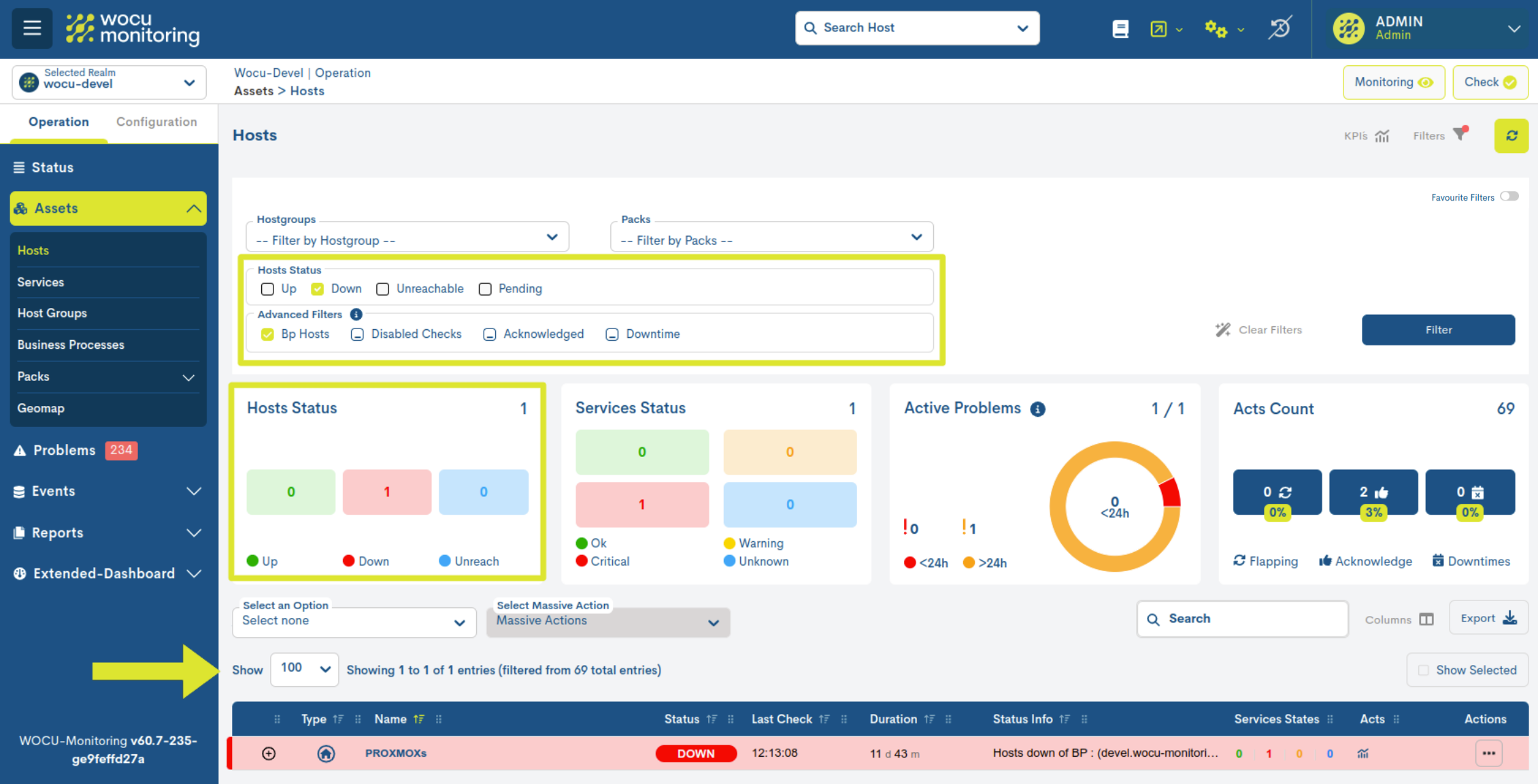
Summary view
By activating the icon marked in the following image, the previous KPIs are displayed, but in a more compact format for quick reading:

Likewise, it is possible to hide the panel block by toggling both buttons.

Inventory operational options: filters and exporting
WOCU-Monitoring has a series of very useful options that facilitate the handling of monitored devices. The combined use of filters and actions allows for a more organized management of assets in complex environments.
By default, all filtering options are hidden, leaving a wider and uncluttered space for viewing and reading data. Just click on the Filters option followed by the funnel icon funnel icon (see image) and the available filters will be displayed.
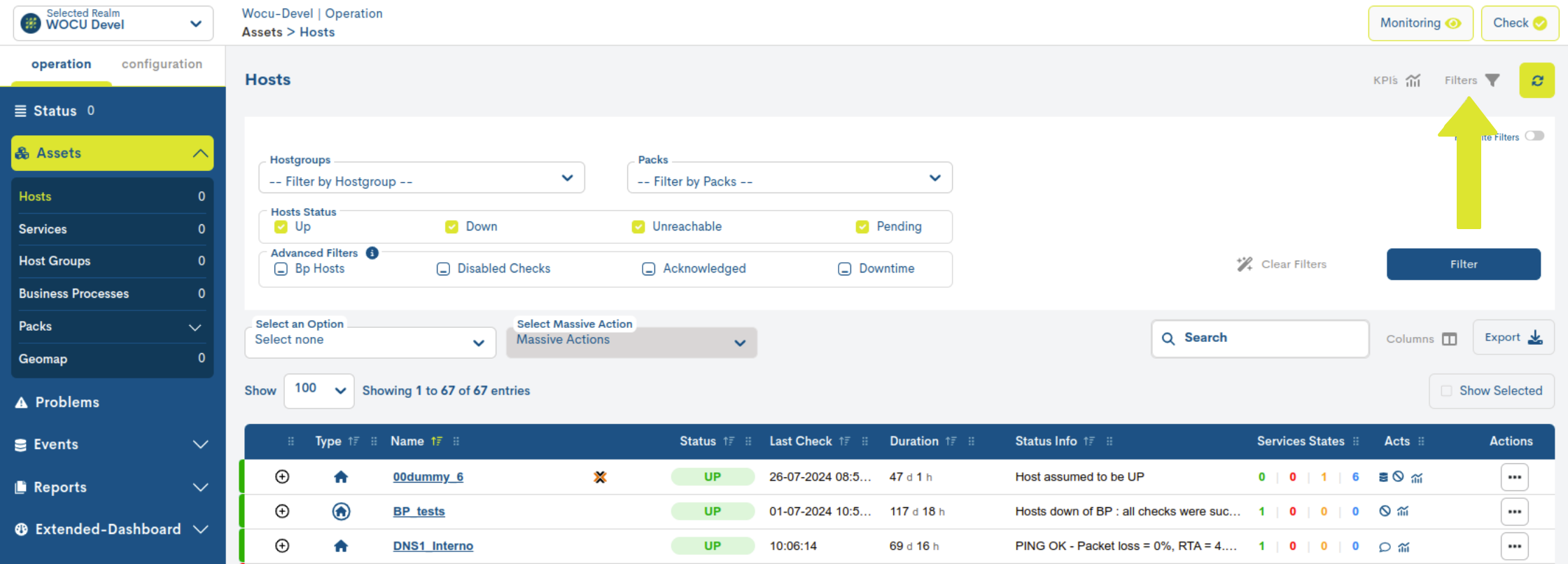
The actions and filters applicable on inventory items are described below:
Filter by Host Group
The Filter by Hostgroup selector modifies the display of the overall inventory, showing only the devices belonging to the chosen Host Group selected by the operator.

To deselect the filter by Host Group and show all hosts, simply choose the first option in the drop-down list (–Filter by HostGroup–).
Attention
The applied filter will be taken into account during the export (in CSV or JSON) of the displayed inventory.
Filter by Monitoring Packs
This drop-down lists the Monitoring Packs that are being applied on the Hosts that are part of the Realm.

By selecting one of them, the table will be filtered by showing only the Hosts that make use of the chosen pack, as shown in the following image:

Host filtering by status type
These filtering options modify the display of hosts according to their current status. With this filter, it is easy to select elements that are in a specific monitoring state.
By default, all checkboxes/states are marked, indicating that the inventory is displaying all devices without filtering by any specific state. Its operation is very simple; clicking on a checkbox toggles the filtering option. Note that once a checkbox is marked, it will display a checkmark inside (✓).

Finally, once the filters have been configured, the changes must be saved by clicking on the blue Filter button, in order to reload the inventory with the new data request.
Advanced Filters
The application provides another advanced filtering system for monitoring the inventory, making it easier to choose and view items that fall within certain categories or operational situations.

Possible actions are:
BP Host: filtered by asset type, specifically, by Business Processes.
Disabled Checks: filtering of assets where the user has applied the Disable active checks for services action.
Acknowledged: filtering of assets where the user has applied the action Apply acknowledged to service.
Downtime: filtering of assets where the user has applied the action Schedule downtime to service.
The operation in this mode allows the concatenation of filters, offering various combinations to the operator for the direct visualization of data of interest. This is possible because each filter can assume 3 states summarized in the following table.
Icon |
Value |
Description |
|---|---|---|
ー |
Off |
The filter is not enabled. The table displays all items by default. |
✔ |
True |
Filter enabled. The table is updated to display items that meet the filter condition. |
✖ |
False |
Filter enabled. The table is updated to hide items that meet the filter condition. |
Note
Simply mark the filtering box repeatedly to cycle through the different undefined states.

Let’s illustrate this explanation with an example:

The inventory will exclusively display BP Hosts that have the Acknowledged option enabled in their configuration and do not have disabled checks (Disabled check). In this scenario, the existence of scheduled downtimes (Downtime) will not be taken into account.
The use and combination of filters allow for a more organized management of vast and complex systems.
Custom Filters
The application offers further advanced options for customised filtering of the items in the list. These filters allow users to nest and define more specific criteria to segment the information according to their needs, by using certain categories or logical operations.
To display the custom filter package you will need to enable the Custom Filters tab.

The available options are:
Host Status
Allows you to filter alarms that belong to assets in a particular monitoring state.
Advanced filters
Corresponds to the Filtros avanzados (Advanced Filters) module present in the alarm listing and works in a similar way.

Filters selector
In this selector, a set of filtering options are presented, corresponding to the fields of the device inventory and which are configured by applying conditions to the items listed in the table. This allows for more precise searches. The items displayed under each filtering option are operators, which define the logic of comparison between an attribute and a value.

a. Basic filters
Filter
The available operators are:
Search
~ (similar to): search for elements that contain a partial match or pattern with the specified value.
Comment
~ (similar to): search for elements that contain a partial match or pattern with the specified value.
!~(not similar to): search for items that do not contain the partial or pattern with the specified value.
!= (other than): search for items that are different from the specified.
= (equal to): search for items that exactly match the specified.
Host
Hostgroup
Plugin output
Services
Packs
!= (other than): search for items that are different from the specified.
= (equal to): search for items that exactly match the specified.
For example…
If the = operator is used in conjunction with a value, problems whose specified attribute exactly matches that value will be located.
If != is used, problems matching this value.
b. Temporary filters
Filter
Operators
Number of services
= (equal to): filter out items that exactly match the specified.
!= (other than): filter out items that are different from the specified
<= (less than or equal to): filters out items whose value is less than the value specified.
>= (greater than or equal to): filters out items whose value is greater than the value specified.
uration
< (lesser): filters out items whose value is less than the specified value.
> (greater): filters out items whose value is greater than the specified value.
Last Check
c. Filter Parent
This is a filter for assets that are hierarchically related. This filter allows you to focus on elements that have a dependency or hierarchy with others.

The following are the operators that can be used to execute the query:
Filter
Operators
Parent
= (equal to): filter out items that exactly match the specified.
!= (other than): filter out items that are different from the specified
~ (similar to): search for elements that contain a partial match or pattern with the specified value.
!~(not similar to): search for items that do not contain the partial or pattern with the specified value.
d. Filter by Tags
The user can freely define and assign descriptive tags to assets to facilitate their search, classification, and location within the system.
The Tags filter criterion follows the format name = value, where the first cell corresponds to the Name, attribute or category of the asset you want to filter, followed by the search operator selector, and then the Value cell, where the specific value assigned to that attribute should be entered.
Ej.:
device_type = routerorlocation = datacenter-1.
The following are the operators that can be used to execute the query:
Filter
Operators
Tag
= (equal to): filter out items that exactly match the specified.
!= (other than): filter out items that are different from the specified
e. Custom Variable Filter
It has a text field that allows the user to enter a custom filter based on a specific variable, offering flexibility to adjust search conditions to suit their needs.
The following are the operators that can be used to execute the query:
Filter
Operators
Custom variable
= (equal to): filter out items that exactly match the specified.
!= (other than): filter out items that are different from the specified
~ (similar to): search for elements that contain a partial match or pattern with the specified value.
!~(not similar to): search for items that do not contain the partial or pattern with the specified value.
Finally, the AND button is available, which allows you to add rows to add search conditions and further refine the query.
Nullify filters: OR and Duplicate
The system allows combining multiple conditions or complete search configurations to obtain more specific or broader results.
Nesting filters using the OR operator: this operator allows multiple to include multiple conditions, where any one of them can be true for the filter to be applicable. Therefore, nesting filters with OR broadens the results by including any of the conditions.

Duplicate queries: this action creates a new instance from an already defined. By duplicating a query, you can modify the search conditions in each copy without altering the original query.

When you combine the OR operator and the duplicate queries, you can gain greater flexibility and control over the results, allowing for highly customised searches. By doing so, more complex filters can be created that include several different conditions or different criteria, both in parallel searches and in alternative conditions within the same query.
Finally, to confirm the desired filter settings, the Filter button must first be pressed.
Massive actions on inventoried hosts
This functionality allows applying the previous actions presented on several hosts, being able to perform massive tasks. By selecting at least two hosts from the inventory, this tab will display a set of actions that will be applied on the set of selected elements.
Mass actions enable a more organized management of large amounts of data in vast and complex environments.
Element management is carried out through the following dropdowns:

Select an option
Clicking on this dropdown displays all the options for selecting items from the list. These are:
Select none: to toggle the previously chosen selection.
Select All: select the complete listing.
Select Current Page: select only the current page from the list. This option can be used in concatenated form, i.e. select Select Current Page: select only the current page in the list and add up the items they contain.
It is also possible to manually select items from the list by clicking on each of them. To select multiple items, hold down the CTRL key while clicking on each item you want to choose. To toggle the action, click again on the item to remove it from the selection.

Selection of the bulk action
Clicking on this dropdown lists the possible actions to apply to the selected set of elements. These correspond to those described in Actions on inventoried hosts.

Filter button
To consolidate the desired filter configuration, it will be necessary to activate the Filter action beforehand, to reload the inventory with the new data request launched.

Button for clearing applied filters (Clear Filter)
When the intention is to clear the applied filters, you can click the Clear filter button, and the configuration will be immediately restored, except for the search conducted in the Search bar.

Show Applied Filters Button
The Show Selected Hosts button acts as a manager for selected assets within the devices list, displaying the items that have recently been marked by the user.

This button will be disabled when there are no selected assets, appearing in a subdued blue color.

Clicking on the functionality will open a new window where it is possible to edit the set of chosen assets.

This management view consists of the following elements:
Selection of entries to display and search bar.
Selection table: the following columns are distinguished:
Type: This field hosts an identifying icon for the type of host according to its nature. The possible options are:
Independent devices identified with the icon of a house.
Business Process (BP Host) devices: identified with the icon of a house framed in a circle.
Host: Selected Device.
Realm: Realm to which it belongs.
Deselect Action: by clicking on the cross icon (X), the corresponding Service will be removed from the table and automatically deselected from the inventory.
Quick action for deselecting all items in the table.
Exportation of Host Inventory Data
Although WOCU-Monitoring provides a multitude of functions for data management, metrics, graphics, etc., at some point, the use of other external tools may be required to handle such information. To address this, the export function is integrated, which facilitates downloading inventory data to a file on the hard disk for processing or later use.

CSV
Clicking on the respective button will open a new modal for the selection and marking of parameters to export based on the user’s criteria. The available options are:
Host Name (Mandatory)
Host Display Name (Mandatory)
Address (Mandatory)
Realm Name (Mandatory)
Groups
Type
State
Last Check
Duration
Last Hard State change
Status Information
Services Ok percentage
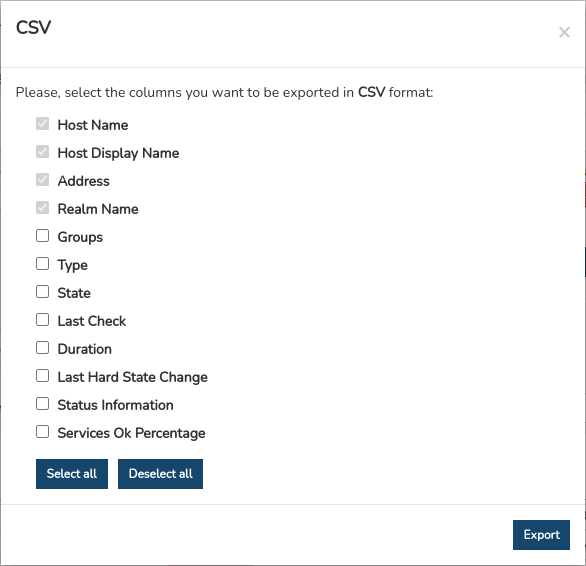
Once the selection is confirmed, the download of a file in CSV (Comma Separated Value) format begins. This format is very simple, organizing columns with a separator (semicolon ‘;’) and rows with a line break.
JSON
This option follows the same process as the previous case but initiates the download of a file in JSON (JavaScript Object Notation) format. JSON is a lightweight data interchange format that can be read by any programming language, making it suitable for exchanging information between different technologies.
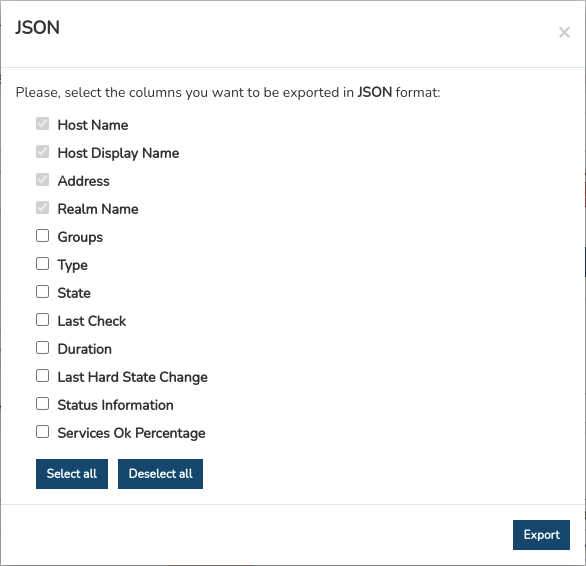
In both options, the system will provide the option to select the directory to download and store the generated inventory file and assign an alternative name to it. By default, the system assigns the following name:
assets_hosts_[nombre del reino]_00h-00min_dd-mm-aaaa y la extensión ``.csv`` o ``.json`` según la opción escogida.
Attention
If an option to filter by Device Group (Filter by HostGroup) is enabled, only the assets belonging to the specified device group (HostGroup) will be included in the export file. In other words, the same filter applied on the screen will be applied to this export. To obtain the export of all assets, the user must ensure that the option for this filter is disabled.






